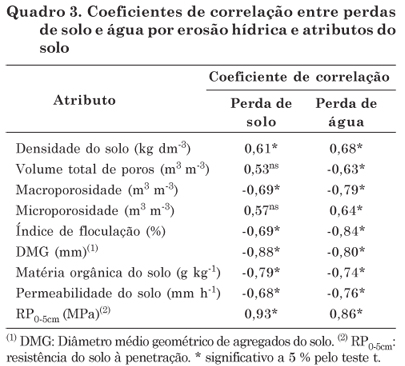In tropical regions, the damage caused to soil by rainwater, i.e., soil erosion, is the most significant form of soil degradation. In Brazil, eucalyptus plantations are mainly located in ecosystems sensitive to anthropogenic disturbances for reasons such as the occurrence of plantations in soils with low clay contents, soils with low natural fertility, and most plantations being established on areas previously occupied by agriculture or by degraded pastures. Thus, the need arises for understanding the processes that control water erosion and their relationship to soil and water losses in forest systems. The aim of this study was to calculate the values of rainfall erosivity (R factor - EI30), to estimate tolerance to soil loss (T) for the representative soil classes in the areas under study, to evaluate soil and water losses by water erosion, and, through the use of principal component analysis (PCA), to verify the influence of soil physical attributes and soil organic mater (SOM) on water erosion in the post-planting stage, with minimum tillage. Treatments consisted of different systems of waste management and planting arrangements (contour and downslope) in two distinct biomes, cerrado (tropical savanna) and forest, and bare soil. The soils were classified as Latossolo Vermelho distrófico típico (Oxisol), upper-middle texture in forest phase (LVd1), and Latossolo Vermelho distrófico típico (Oxisol), medium-low texture in cerrado phase (LVd2). The study was conducted in experimental areas of eucalyptus plantations located in Três Lagoas, in the Parana River basin, eastern Mato Grosso do Sul, Brazil. The annual erosivity index obtained was 6,792.7 MJ mm ha-1 h-1 yr-1. The T values ranged from 9.0 to 11.0 Mg ha-1 yr-1 for LVd2 and LVd1, respectively. Soil losses for eucalyptus plantation were well below the tolerance limits for the soil classes studied, at 0 to 0.505 Mg ha-1 in LVd1, and 0 to 0.853 Mg ha-1 no LVd2. Among the forest systems, eucalyptus under contour planting with maintenance of the residue was closest to native vegetation in relation to soil and water losses. The PCA proved to be effective in discriminating management systems based on the interaction between physical properties and soil organic matter and their relationship to water erosion, enabling clear visualization of the influence of soil management systems on these properties and their relationship to soil and water losses.
erosivity; tolerance to soil loss; USLE/RUSLE; eucalyptus; principal component analysis






